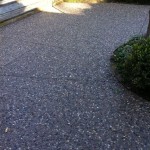Sealing Concrete Patio Slabs: Protecting Your Outdoor Oasis
Concrete patio slabs offer a durable and versatile surface for outdoor living spaces. However, like any other material, concrete is susceptible to damage and deterioration over time. Sealing concrete patio slabs is crucial for extending their lifespan, enhancing their appearance, and making them more resistant to the elements. This process involves applying a protective coating that creates a barrier against moisture, stains, and weathering.
Understanding the Benefits of Sealing Concrete Patio Slabs
Sealing concrete patio slabs offers numerous advantages that contribute to both the functionality and aesthetics of your outdoor space:
1. Protection Against Moisture and Staining
Concrete is a porous material, meaning it can absorb water and other liquids. This absorption can lead to staining, efflorescence (a white powdery deposit on the surface), and even structural damage over time. A sealant creates a protective barrier that prevents moisture from penetrating the concrete, minimizing the risk of staining and damage.
2. Enhanced Durability and Longevity
Sealing your concrete patio slabs helps to protect them from the harsh effects of UV rays, frost, and chemicals. It also creates a smoother surface that is less susceptible to cracking and chipping. By minimizing these forms of damage, sealing helps to extend the lifespan of your patio slabs and reduce the need for costly repairs or replacements.
3. Improved Appearance and Aesthetics
A sealant can enhance the natural beauty of your concrete patio slabs by bringing out their color and texture. Some sealants even provide a glossy or satin finish, adding a touch of elegance to your outdoor space. Additionally, sealing helps to protect the concrete from dirt and grime, keeping it looking clean and fresh for longer.
Choosing the Right Sealant for Your Patio Slabs
There are various types of sealants available on the market, each with its own unique characteristics and benefits. The best sealant for your concrete patio slabs depends on several factors, including the type of concrete, the climate, the desired finish, and your budget. Some common types of sealants include:
1. Acrylic Sealants
Acrylic sealants are water-based and offer good protection against moisture and UV rays. They are typically easy to apply and dry quickly, making them a popular choice for homeowners. However, acrylic sealants may not be as durable as other types, especially in areas with heavy foot traffic or extreme weather conditions.
2. Silane-Siloxane Sealants
Silane-siloxane sealants are a more durable and water-resistant option compared to acrylic sealants. They penetrate the concrete pores and form a strong protective barrier. This type of sealant is suitable for both interior and exterior applications and can withstand harsh weather conditions.
3. Epoxy Sealants
Epoxy sealants offer the highest level of protection against moisture, stains, and abrasion. They are often used in high-traffic areas or on surfaces that are exposed to harsh chemicals. However, epoxy sealants can be more difficult to apply and may require professional installation.
Proper Application and Maintenance
Once you have chosen the appropriate sealant for your concrete patio slabs, it's important to apply it correctly to ensure optimal performance. Here are some key steps to follow:
1. Preparation
Before applying the sealant, thoroughly clean the concrete surface to remove dirt, debris, oil, and grease. Use a pressure washer or a stiff brush to remove any stubborn stains. Allow the concrete to dry completely before proceeding.
2. Application
Apply the sealant according to the manufacturer's instructions. Use a roller, brush, or sprayer to evenly distribute the sealant over the entire surface. Avoid applying too much sealant, as this can lead to a sticky or uneven finish.
3. Curing
Allow the sealant to cure completely before using the patio. The curing time will vary depending on the type of sealant and the weather conditions. Follow the manufacturer's instructions for the recommended curing time.
4. Maintenance
Regular maintenance is essential to prolong the life of your sealant. Regularly sweep or vacuum the patio to remove dirt and debris. Avoid using harsh chemicals or abrasive cleaners that can damage the sealant. In case of spills or stains, clean them up promptly to prevent them from penetrating the concrete..
Sealing your concrete patio slabs is an investment that will pay off in the long run. By protecting your patio from the elements and enhancing its appearance, you can enjoy your outdoor space for years to come.

Sealing A Concrete Patio What S The Best Sealer Network

How To Seal A Patio 6 Steps Sealing Slabs Perfectly Every Time

Wet Look Patio Sealer Best On Stone Slate Sandstone With A 3 For 2 Deal

Why You Should Seal Your Concrete Driveway Or Patio Gleam Team

Wet Look Patio Sealer Best On Stone Slate Sandstone With A 3 For 2 Deal

Wet Look Patio Sealer Best On Stone Slate Sandstone With A 3 For 2 Deal

Should I Seal My Patio Slabs Pros And Cons What To Expect

Wet Look Patio Sealer Best On Stone Slate Sandstone With A 3 For 2 Deal

How To Seal A Patio Guide Primethorpe Paving

Satin Finish Stone Sealer Protect Your Patio 3 For 2 Offer








